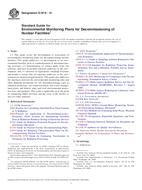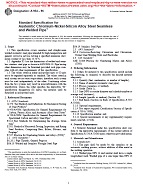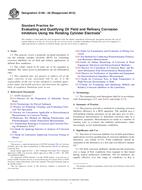1.1 These test methods cover the determination of metals in solution by atomic absorption spectroscopy (AAS).
1.2 The following sections outline the operating parameters for the individual metals:
Sections Aluminum, Direct Aspiration 12 Aluminum, Furnace Technique 13 Antimony, Direct Aspiration 14 Antimony, Furnace Technique 15 Arsenic, Furnace Technique 16 Arsenic, Gaseous Hydride Method 17 Barium, Direct Aspiration 18 Barium, Furnace Technique 19 Beryllium, Direct Aspiration 20 Beryllium, Furnace Technique 21 Cadmium, Direct Aspiration 22 Cadmium, Furnace Technique 23 Calcium, Direct Aspiration 24 Chromium, Direct Aspiration 25 Chromium, Furnace Technique 26 Chromium, Chelation-Extraction 27 Chromium, Hexavalent, Chelation-Extraction 28 Cobalt, Direct Aspiration 29 Cobalt, Furnace Technique 30 Copper, Direct Aspiration 31 Copper, Furnace Technique 32 Iron, Direct Aspiration 33 Iron, Furnace Technique 34 Lead, Direct Aspiration 35 Lead, Furnace Technique 36 Lithium, Direct Aspiration 37 Magnesium, Direct Aspiration 38 Manganese, Direct Aspiration 39 Manganese, Furnace Technique 40 Mercury, Cold Vapor Technique 41 Molybdenum, Direct Aspiration 42 Molybdenum, Furnace Technique 43 Nickel, Direct Aspiration 44 Nickel, Furnace Technique 45 Potassium, Direct Aspiration 46 Selenium, Furnace Technique 47 Selenium, Gaseous Hydride 48 Silver, Direct Aspiration 49 Silver, Furnace Technique 50 Sodium, Direct Aspiration 51 Tin, Direct Aspiration 52 Tin, Furnace Technique 53 Titanium, Direct Aspiration 54 Titanium, Furnace Technique 55 Vanadium, Direct Aspiration 56 Vanadium, Furnace Technique 57 Zinc, Direct Aspiration 58 Zinc, Furnace Technique 59
1.3 Detection limits, sensitivity, and optimum ranges of the test methods will vary with the various makes and models of atomic absorption spectrophotometers. The data shown in Table 1 provide some indication of the actual concentration ranges measurable by direct aspiration and using furnace techniques. In the majority of instances, the concentration range shown in the table by direct aspiration may be extended much lower with scale expansion and conversely extended upwards by using a less sensitive wavelength or by rotating the burner head. Detection limits by direct aspiration may also be extended through concentration of the sample or through solvent extraction techniques, or both. Lower concentrations may also be determined using the furnace techniques. The concentration ranges given in Table 1 are somewhat dependent on equipment such as the type of spectrophotometer and furnace accessory, the energy source, and the degree of electrical expansion of the output signal.
1.4 When using the furnace techniques, the analyst should be cautioned as to possible chemical reactions occurring at elevated temperatures that may result in either suppression or enhancement of the analysis element. To ensure valid data with furnace techniques, the analyst must examine each matrix for interference effects (see 6.2) and if detected, treat accordingly using either successive dilution, matrix modification or method of standard additions (see 10.5).
1.5 Where direct aspiration atomic absorption techniques do not provide adequate sensitivity, in addition to the furnace procedure, reference is made to specialized procedures such as gaseous hydride method for arsenic and selenium, the cold-vapor technique for mercury and the chelation-extraction procedure for selected metals.
1.6 This standard may involve hazardous materials, operations, and equipment. This standard does not purport to address all of the safety problems associated with its use. It is the responsibility of the user of this standard to establish appropriate safety and health practices and determine the applicability of regulatory limitations prior to use. For hazard statement, see 8.4 and 17.2.3.
Product Details
- Published:
- 01/01/1996
- Number of Pages:
- 27
- File Size:
- 1 file , 240 KB


